静电纺丝技术是一种新型制备纳米纤维薄膜的方法,在生物,环境,储能等领域展现出了很高的应用前景。近日,东华大学的丁彬教授带领的课题组制备了一种能够高效率分离油水乳液的纳米纤维薄膜,相关研究发表在Journal of Materials Chemistry A上。
在过去的几十年里,由于工业含油污水排放量的增加和频繁的漏油事故引起的水污染问题日益严峻,严重影响了自然环境与人类健康。如何高效的处理含油污水,尤其是“水包油”型的乳液是一个世界性的难题。 目前,处理含油污水的方法有生物降解,化学破乳,空气悬浮或者是吸附等方法,但是这些方法由于技术复杂,成本高昂,限制了其应用。利用微滤膜和超滤膜进行水油分离的膜分离技术被认为是一种高效低耗的处理“水包油”型的乳液的好方法。因此,关于分离膜的设计则成为了该技术的核心问题。
基于静电纺丝的纳米纤维薄膜具有孔隙发达,比表面积高,以及微观结构可被调控的特点。所以利用静电纺丝制备分离薄膜是当今膜分离技术的一个研究热点。东华大学的丁斌教授带领的课题组通过静电纺丝、制备了一种超亲水,并且在水中超疏油的复合纳米纤维薄膜,这种复合纳米纤维薄膜对油水混合乳液展现出了非常高的分离效率,以及很好的抗污性和非常高的通过量。
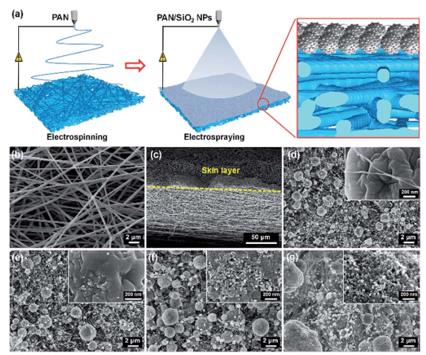
Fig. 1 (a) Schematic illustration showing the fabrication procedure of nanofibrous separation membranes with hierarchical structured skin. (b) SEM image of the pristine NFM. (c) Cross-sectional SEM image of the composite membrane. (d–g) Enlarged top-view SEM images of omposite membranes with microspheres incorporating different amounts of SiO2 NPs
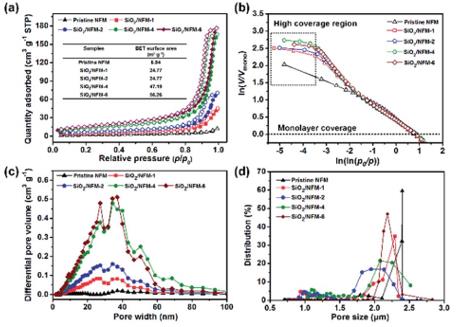
Fig. 2 (a) N2 adsorption–desorption isotherms of the pristine NFM, and composite membranes with microspheres incorporating various amounts of SiO2 NPs. (b) The corresponding FHH plots reconstructed from the relevant N2 adsorption isotherms. (c) The calculated PSD curves of the relevant membranes using the DFT method based on the N2 adsorption–desorption isotherms. (d) PSD analysis of the membranes using the bubble point method.
如图1所示,作者以聚丙烯腈溶液为前驱体,利用静电纺丝制备纳米纤维薄膜。然后利用静电喷雾的方法,将聚丙烯腈和二氧化硅的混合溶液以微球状喷涂在纳米纤维薄膜上。大量的微球相互之间紧密结合,形成了一层质密的超亲水表层,这种表面结构有利于吸附和保留水分子,从而形成一种对油滴不亲和的液-固混合界面,保证了薄膜的抗污染性。从图2中也可以看出来,这种复合纳米纤维薄膜有非常发达的孔隙结构,十分有利于水分子的传输。在图3中我们可以看到,这种复合纤维薄膜对水中的油滴有很弱的亲和性,显示出了超疏油性。
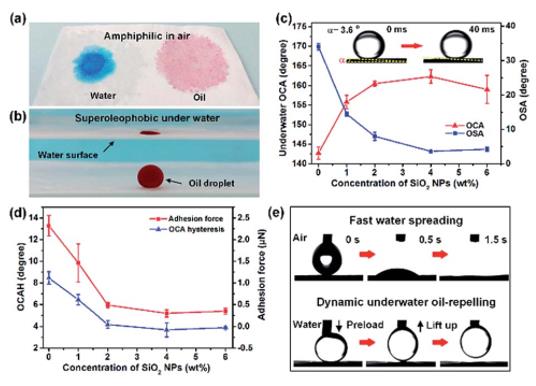
Fig. 3 (a) Photograph showing the amphiphilicity of the membrane towards water (dyed blue) and oil (dyed red) in air. (b) An oil droplet on the surface of pristine NFM underwater. (c) The underwater OCA and OSA of various membranes as a function of SiO2 NP concentration. The inset shows an image of an oil droplet sliding on the surface of SiO2/NFM-4. (d) The underwater OCAH and the calculated retention forces. (e) Photographs of dynamic measurements of water spreading (top) and underwater oil-adhesion (bottom) on the surface of SiO2/NFM-4.
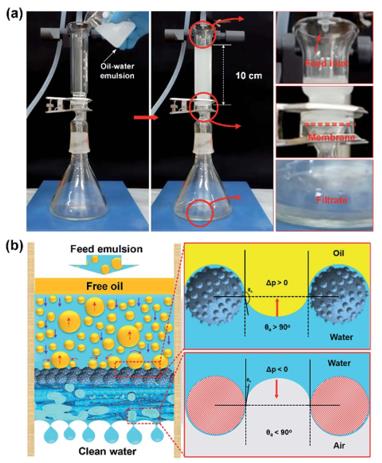
Fig. 4 (a) Photographs showing apparatus for the gravity-driven separation of oil-in-water emulsions with a continuous fluid infusion to maintain a stable liquid level. (b) Schematic diagram illustrating the plausible mechanism of the oil-in-water emulsion separation: oil droplets roll round and coalescence on the surface; oil was sustained by the hierarchical structured microspheres trapping the water layer at the interface; water transported into the channels formed by the nanofibers.
由于这种复合纤维薄膜具有发达的孔隙结构和超强的疏油性,因此重力的作用下,就实现了对“水包油”型的乳液的很好的分离。如图4显示,水分子优先在薄膜表层形成一层对油滴不亲和液-固混合界面,由于薄膜的疏油性,油滴在薄膜表面聚集,形成大的油滴,回到液体表面形成自由油层。而水分子借助孔隙结构,通过毛细作用,可以通过薄膜层,进而实现油水分离。
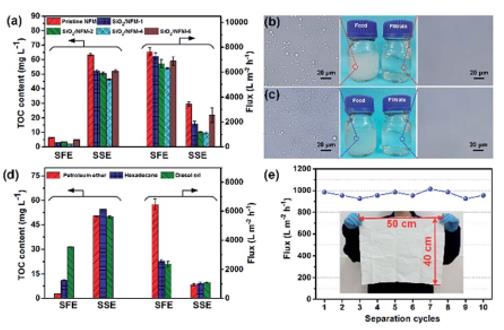
Fig. 5 (a) TOC values of the corresponding filtrates and separation fluxes of different membranes for emulsions (n-hexane-in-water). (b and c) Digital photographs and optical microscopy images of the SFE and SSE, respectively, before and after separation. (d) TOC values of the filtrates and separation fluxes of the SiO2/NFM-4 membrane for various oil-in-water emulsions. (e) The change of flux in the separation of surfactant-stabilized emulsion over 10 cycles by using SiO2/NFM-4. The inset photograph shows a large scale membrane with size of 50 cm x 40 cm.
本研究由东华大学的丁斌教授完成,于2016年11月发表在Journal of Materials Chemistry A上。
论文信息:Ge, J., Zhang, J., Wang, F., Li, Z., Yu, J., & Ding, B. (2016). Superhydrophilic and underwater superoleophobic nanofibrous membrane with hierarchical structured skin for effective oil-in-water emulsion separation. Journal of Materials Chemistry A, 5(2).
